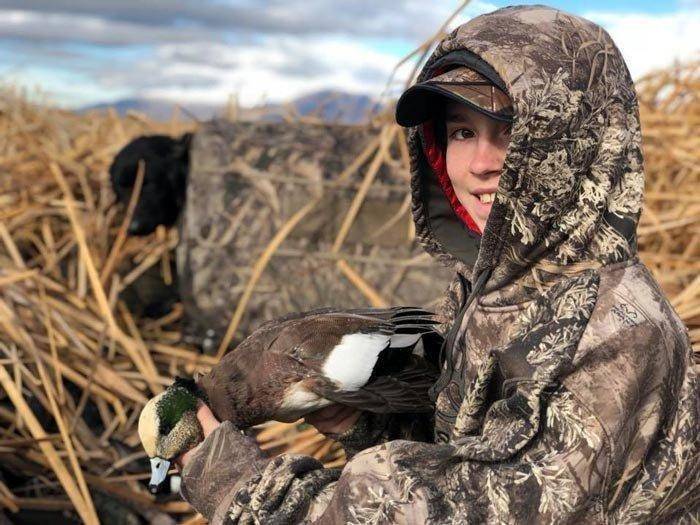It’s almost time to hunt ducks in Utah. The state’s waterfowl hunt starts Oct. 6 in the Northern Hunting Zone.
DWR Press Release
General waterfowl hunt starts Oct. 6 in Northern Hunting Zone
If you enjoy hunting ducks in Utah, you might be wondering if there will be enough water to put your duck decoys on this fall.
Despite an extremely hot, dry summer, Blair Stringham has good news for those who enjoy hunting marshes along the eastern shore of Great Salt Lake: wetlands inside state waterfowl management areas, stretching from Salt Creek on the north to Timpie Springs on the south, are looking really good this year. See conditions at waterfowl management areas across Utah.
“Our managers were able to keep water on the ponds throughout the summer,” says Stringham, migratory game bird coordinator for the Division of Wildlife Resources. “Keeping water on the ponds, coupled with work to remove carp from the ponds, has led to great pondweed growth. There’s plenty of food and water for the birds.”
And that’s not all: years of work to control invasive phragmites is paying off, especially in wetlands on the outside edge of many of the WMAs.
Stringham recently flew over the marshes on the eastern shore of the lake. “Years and years of phragmites treatments have opened up new wetlands,” he says, “and the birds are using these areas heavily. The areas looked awesome. From the sky, it looked like a totally different world down there.”
Utah’s general waterfowl hunt opens Oct. 6 in the Northern Hunting Zone and Oct. 13 in the Southern Hunting Zone. Stringham expects duck and Canada goose numbers to be down slightly this fall, but — with between 3 million to 5 million ducks passing through Utah — there will still be plenty of birds to hunt.
He provides more information about wetland conditions and access:
Dry ponds at the Harold Crane WMA
A project to improve water flow and dredge a boat channel in the South Pond at the Harold Crane WMA is still underway. Both the South Pond and the West Pond are completely dry, and the gate to the main parking lot has been closed to keep the area secure while construction work happens. The project should be completed by mid to late October. As soon as it wraps up, managers will fill the ponds with water and open the gates to the parking lot.
More places to hunt at the Bear River Migratory Bird Refuge
The U.S. Fish and Wildlife Service has opened 13,000 additional acres at the Bear River Migratory Bird Refuge to waterfowl and pheasant hunting. You can see all of the areas open to hunting at https://bit.ly/2pdZj9p. More information about water conditions at the refuge are available at www.fws.gov/refuge/bear_river_migratory_bird_refuge.
Dry conditions elsewhere
While wetland conditions are good at the seven state WMAs along the eastern shore of Great Salt Lake, conditions are much drier at WMAs across the rest of Utah. Marshes in both Cache and Rich counties, and in the Uinta Basin, are much drier too.
Sandbars and a changed landscape
If you enjoy hunting the four freshwater areas on the eastern side of Great Salt Lake — Bear River Bay, the Willard Spur, Ogden Bay and Farmington Bay — the water level is much lower this year. “If you have an airboat,” Stringham says, “you should still be able to access these areas and have good hunting. If your boat has a mud motor on it, though, you might have some challenges.”
If you’re able to access these areas, watch for sandbars. Also, be aware that the topography has changed. “Healthy marsh lands are starting to replace areas that were dominated by phragmites,” Stringham says. “Hunting will be awesome in these areas, but it’s important to get out and scout them. In many places, the landscape looks entirely different than it did a year or two ago.”
The state’s WMAs opened to scouting on Sept. 20.
Two areas funded by the Utah Waterfowl Slam
Stringham says two areas, recently created through dollars raised by the Utah Waterfowl Slam, look great this year. He says ducks are using them heavily.
“One area — the Teal Lake unit — is living up to its name,” he says. “Hundreds of cinnamon teal and some green-winged teal are using it right now.”
Teal Lake is part of the Farmington Bay WMA. The unit is directly west of Unit 1.
Stringham says the second area, located at the North Run area on the north side of the Ogden Bay WMA, is also being heavily used by birds right now.
You can learn more about, and join, the Utah Waterfowl Slam.

